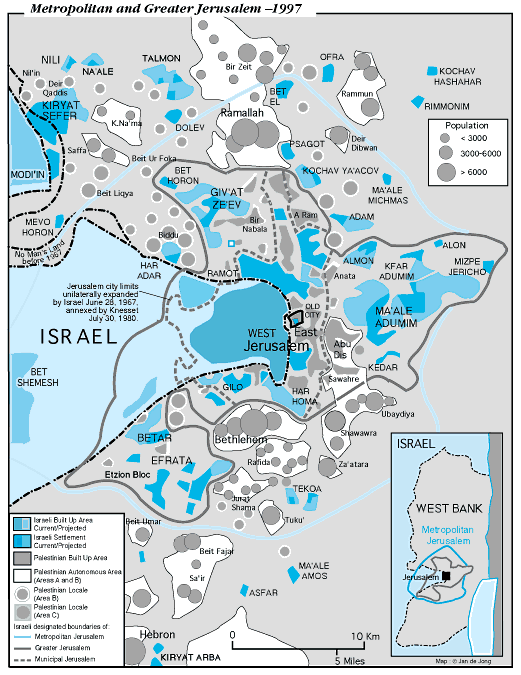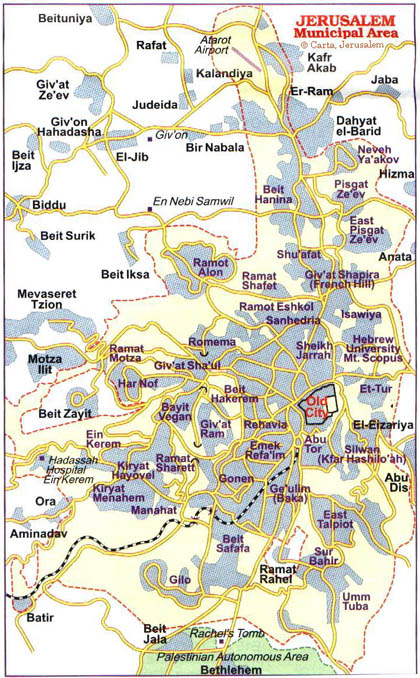
|

|
| THINK-ISRAEL |
| HOME | September-October 2007 Featured Stories | Background Information | News On The Web |
When most tourists think of Jerusalem, they generally have in mind the Western Wall, the Israel Museum, the Church of the Holy Sepulchre, Ben Yehuda Mall and Yad Vashem. Sadly, tourists, like most Israeli Jews, don't spend much time in eastern Jerusalem--despite the fact that this part of the Holy City holds the most historical, spiritual and strategic significance for Jews and Christians.
But in the run-up to the Annapolis summit, as the Olmert and Bush administrations intone the old "two states for two peoples" mantra, and renewed declarations that a Palestinian state will have east Jerusalem as its capital go on, perhaps it's time to understand the dynamics of the eastern part of the city.
Until very recently, Israeli politicians both left and right cited "Jerusalem, the undivided capital of Israel" as the consensus mantra. Now, Deputy Prime Minister Haim Ramon, (the same Ramon who was convicted just six months ago on sexual harassment charges) is advancing the same unrealistic Camp David thinking on Jerusalem as that first raised by Ehud Barak in 2000. Let the Arabs have the Arab neighborhoods and the Jews will keep the Jewish areas, and the "Holy Basin" of Judaism and Christianity's holiest sites will be administered by joint international supervision, declares Ramon.
But, as anyone who has spent any time at all in Jerusalem's neighborhoods can attest, things on the ground are far more complex than that.
For some American and European politicians, Jewish development in eastern Jerusalem is a provocation and a threat to the 'peace process.' Thus, the idea that Jews have the right to build and live wherever they wish in Jerusalem, under Israeli sovereignty, is an unacceptable concept.
But without the strategic assets of pockets of Jewish settlement in eastern Jerusalem, the city would indeed be divided, de facto. Jews would continue to work and live in the western section, and Arabs would predominate in the eastern part of the city where so much of Jewish history took place.

|

|
The idea of surrounding the inner core of Jerusalem with areas of Jewish settlement is not new. Successive Israeli governments since 1967 have consistently carried out this policy--developing the neighborhoods of Maaleh Adumim, Pisgat Zeev, Givat Zeev, East Talpiot and the re-established Neve Yaakov (founded in 1924). Even a cursory look at a map of greater Jerusalem will reveal that these communities play a crucial role in forming a buffer against Palestine Authority efforts to achieve territorial contiguity between the Old City and the two nearby areas already under PA control--Ramallah to the north and Bethlehem to the south.
Abu Dis, bordering the Mt of Olives cemetery, remains under Israeli security control, but Palestinian civil control. If this contiguity were to be achieved, the PA will have created a viable capital within shouting distance of the Temple Mount.
Jewish efforts to establish institutions and neighborhoods in eastern Jerusalem include Beit Orot, sitting on the northernmost ridge of the Mt of Olives. Beit Orot encompasses a hesder yeshiva (where students study and serve in the IDF) and development initiative. Located just below the Mt Scopus campus of Hebrew University, the yeshiva, founded by MK Rabbi Benny Elon and former MK Hanan Porat, educates and houses more than 100 students every year. In addition, the Beit Orot site now includes the homes of a number of young families who are waiting for building to start at the site for the first Jewish neighborhood on the Mt of Olives in two thousand years. Just across the road are Beit Orot's neighbors, the Arabs of A-Tur and the Augusta Victoria Hospital.
Down the hill and to the west of Beit Orot lies the newly reclaimed neighborhood of Shimon Hatzaddik (established in 1891). Less than half a mile from Meah Shearim. just north of the Old City, the area is named after the nearby tomb of Shimon Hatzaddik, a sage from the Great Assembly, active in the time of Alexander the Great.. Israeli flags now fly proudly over the complex of small houses and a synagogue/study house that make up the neighborhood that is part of the Sheikh Jarrah area that houses various foreign consulates and Palestinian institutions.
Ownership of the six dunam Shimon Hatzaddik site lies in the hands of the Vaad Sephardi Haredit--a Sephardic communal body whose members populated the area until the Arab riots of the 1920s and 30s drove them out. Jewish organizations have been quietly acquiring the "protected tenancy rights" of the Arab tenants who had squatted there for many years and young Jewish families are now reclaiming the property.
Behind the neighborhood synagogue is a flight of stairs leading to Derekh Har HaZeitim, the road where 77 doctors and nurses trying to reach Hadassah Hospital on Mt Scopus were murdered in 1948. A simple monument marks the spot.
A few years ago, a group of Jewish investors from Israel and abroad signed a deal to purchase 18 dunams of land surrounding the ancient Tomb and plans call for 80 apartment units to be built over the next few years, re-establishing the important Jewish neighborhood.
A larger area of Jewish renewal is Ir David (the City of David), the original biblical city of Jerusalem. Older than the Old City, it is the Ancient City. It lies right below Dung Gate in the southern wall of the old City, the traditional entrance to the Western Wall. Ir David is where King David created his capital and it is there that 3,000 years ago he united Israel and Judea politically, religiously, and economically.
One hundred years ago, Silwan, the area just across the Kidron Valley from Ir David, was home to a Jewish community consisting primarily of Yemenite Jewish immigrants. But it was here that Jerusalem was founded. Not in the old city nor where the Western Wall stands today. So it's not surprising that young Jewish families want to live there today. Dozens of families now make their homes in Ir David surrounded by dozens more Arab residents. Extensive archaeological excavations have been taking place in recent years, and a new visitors center entices people to learn more about Jewish history and has made the site one of the most popular tourist attractions in Jerusalem.
Strategically, strengthening Jewish presence in Ir David is important, since the area lies on the only access route to the Western Wall from the south. Another important strategic asset directly faces Ir David from the opposite side of Silwan, atop the Kidron valley. Maale Hazeitim is another link along the Mt of Olives ridge, and creates a buffer between Abu Dis and the Temple Mount.
The way to Maale Hazeitim is along the old Jericho Road that cuts through the Mt of Olives cemetery, the oldest Jewish burial ground in the world. The site commands a magnificent and unusual view of the Temple Mount, and makes property there most desirable. Construction of the first phase has been completed and some 70 families make their homes there, living peacefully amongst a hundred Arab families in the area they know as Ras el Amud. The project is a private initiative of Florida based philanthropist, Dr. Irving Moskowitz who purchased the property more than 20 years ago.
The site is continually referred to in the international press as being in "traditionally Arab east Jerusalem." Standing on the roof of the site, it's difficult to understand what is traditionally Arab about this area. To the north lies the ancient Mt of Olives Jewish burial ground. Behind the site, to the east is the Israeli police headquarters for Judea and Samaria. Look west and you'll see the City of David and the Temple Mount surrounded by the walls of the Old City; just to the south lies the Christian Monastery of Abraham. The majority of residents living in the neighborhood today are Arab, but that hardly justifies the "traditionally Arab" appellation.
One more area of Jewish development in eastern Jerusalem that is of enormous strategic significance is Har Homa. Located within Jerusalem's municipal boundaries, Har Homa is in the southern part of Jerusalem near Kibbutz Ramat Rachel and Gilo, bordering on PA controlled Bethlehem on one side and the Jerusalem Arab village of Sur Baher to the north. The 1,850 dunam site is on a previously desolate, uncultivated and barren hill.
The building project at Har Homa will ultimately include 6,500 housing units, and already features schools, parks, public buildings, commercial and industrial zones. After years of stalling under the threat of Arab violence, construction on the first stage of 2,456 housing unit finally began on election day, 1999 and hundreds of families have already moved into the neighborhood.
Eastern Jerusalem today is a polyglot of Jews and Arabs that defies simplistic solutions. The days are short before the battle for control of Jerusalem will be decided. Efforts to establish Jewish strategic assets remain the best hope of ensuring that "a united Jerusalem" will mean more than just a slogan.
This article was published October 09, 2007 in Front Page
Magazine
Judy Lash Balint is author most recently of Jerusalem Diaries II:
What's Really Happening in Israel (Xulon Press) Her website
is at www.jerusalemdiaries.blogspot.com.
www.frontpagemag.com/Articles/Read.aspx?GUID=
876D651D-4A2B-4CF9-A821-451D2AD15374
| HOME | September-October 2007 Featured Stories | Background Information | News On The Web |